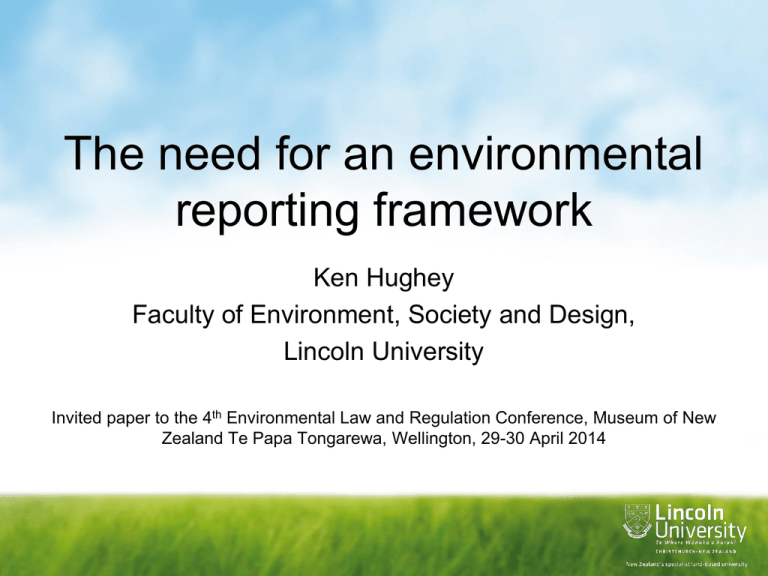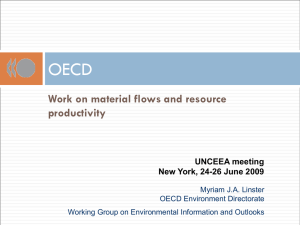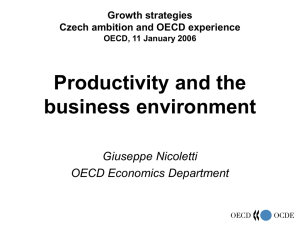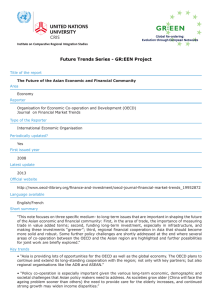The need for an environmental reporting framework Ken Hughey
advertisement

The need for an environmental reporting framework Ken Hughey Faculty of Environment, Society and Design, Lincoln University Invited paper to the 4th Environmental Law and Regulation Conference, Museum of New Zealand Te Papa Tongarewa, Wellington, 29-30 April 2014 A simple need which should be beyond argument Drivers of monitoring & reporting • legislative (RMA – we have to), • honouring international agreements (e.g., CBD), • maintaining global reputation/brand against external scrutiny (OECD reports, e.g., http://www.oecd.org/document/10/0,2340,en_2649_ 34307_37915274_1_1_1_1,00.html), and • due to stakeholder demands (e.g., http://www.mpi.govt.nz/newsresources/publications.aspx?title=Dairying%20and%20Clean%20Streams%20Ac cord:%20Snapshot%20of%20Progress) What do we report on now & at what levels? • Individual firms/industries have their own sustainability reports, e.g., http://www.westpac.co.nz/who-we-are/sustainability-and-community/how-were-tracking/sustainability-reports/ And see also: http://www.sbc.org.nz/resources-and-tools/reports/nzsustainability-reports • Individual regions (e.g., http://www.gw.govt.nz/ser/) and of course countries report frequently using the PSR framework (e.g., http://www.ec.gc.ca/indicateursindicators/default.asp?lang=En) • Sometimes vertically integrated reporting: place, district, region, country, international (see over) Vertical integration of state of environment reporting – using key agreed indicators • Wetland bird monitoring at Te Waihora/Lake Ellesmere • Annual February bird count links volunteers with managers with scientists • Contributes directly, by counting wrybills, to state of the lake report, links to SelwynWaihora Water Mgt Zone reporting, links to MfE national State of the Environment reporting, links to world wide Birdlife International monitoring Horizontal connections in local reports, e.g. – Te Waihora/Lake Ellesmere State of the Lake 2013 • See http://www.wet.org.nz/wpcontent/uploads/2013/10/2013-Nov-State-of-theLake-report1.pdf • Economic, alongside native vegetation, fisheries, water quality etc • Note huge data gaps despite many years of research into aspects of the lake and its environs, esp regarding native fish and recreation Thinking NZ Inc. – where have we come from & where are we heading as a nation? Some national-level context: • NZ’s state of the environment reporting is a bit of an international and national level ‘joke’, and has been since 1997 when country’s 1st SOE released • The Hon Nick Smith said on 18th August 2011: "We are the only OECD country not required by law to produce independent state of the environment reports, yet we more than any depend on our natural environment for so much of our wealth and economic success.” • However, Environmental Reporting Bill introduced to Parliament, February 2014 A choice of reporting frameworks … See MfE 2014, Appendix 2, for a summary, including: • Pressure-State-Response (PSR): used by the OECD and by Hughey et al (2000, 2002, 2004, 2006, 2008, 2010 & 2013) • Driving Force-Pressure-State-Impact-Response (DPSIR) used by European Environment Agency • Ecosystems Services: used by Millennium Ecosystem Assessment and UK National Ecosystem Assessment • Living Standards Framework – NZ Treasury – 5 dimensions: economic growth, managing risks, sustainability, social infrastructure, increasing equity • Measuring NZ’s Progress Using a Sustainable Development Approach – StatsNZ, published 2008 – overlapping indicators • Naturally, NZ has chosen something a bit different … Government’s chosen approach • Pressure-State-Impact framework P = the factors influencing the environment (+ve & -ve) S = biophysical condition of environment I = the ‘so what’ of changing S • But why no Response (when both 1997 & 2007 based on PSR & OECD)? Is this a cop out? What & how will Government report? • Five domains: 1. 2. 3. 4. 5. air, atmosphere & climate, land, fresh water, marine – (note that ecosystems & biodiversity cross cutting & are components of each domain) • Reports released by domain at 6-month intervals; synthesis reports each 3 years • Responsibility for reporting: MfE and StatisticsNZ Issues raised about this approach? • Lack of response reporting • Role of PCE in terms of audit function – will the Commissioner be able to access background data/reports: a clause exists that could restrict this availability • Ministers have the power to decide which specific topic areas will be reported on What role for local government? • Many RCs undertake regular state of the environment reporting & report to MfE • Needs to be vertical integration between regions and central government reporting, using the same indicators – in terms of biodiversity this is already happening • At sub regional council levels, e.g., DCs, zone cttes, also need consistency in indicator choice • Gosh remind me – this is 2014 – should have sorted this out decades ago! And where might business fit in? • Business/industry in the Pressure, Driving Force, Response categories, i.e., what are we doing that impacts on the environment, and what are we doing about it? • Potentially good example in NZ is the Sustainable Dairying: Water Accord – see http://www.wet.org.nz/wp-content/uploads/2013/10/2013-Nov-State-ofthe-Lake-report1.pdf • The accord is of course a response to a driving force to a change in state (deteriorating water quality) Guidance for effective monitoring & reporting: a reminder • Monitoring: – Choose outcome over input/output indicators wherever possible – Ensure indicators meet SMARTA criteria wherever possible, i.e., Specific, Measurable, Achievable, Relevant, Timely, Already in use • Reporting: – – – – – – Engagement Consistency Auditable Transparency Meaningfulness/relevance Understandable Some key conclusions • Must measure (and report) to manage • We have responsibilities to report (Global= OECD & MEA), and we need to report to know we are heading (or not) in the right direction • Multiple reporting frameworks – NZ has changed course & using something different, PSI – does this matter? • There are issues with the current bill – these may be sorted out in the select ctte process • Future under this new regime looking brighter.






